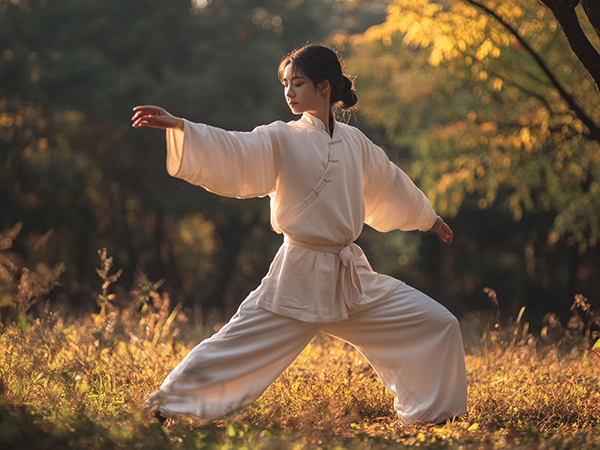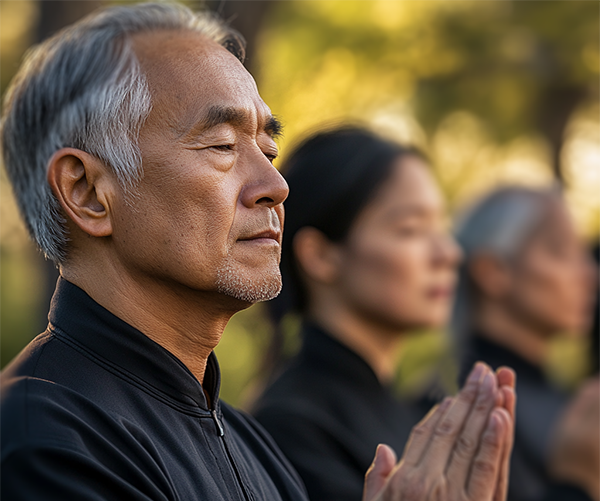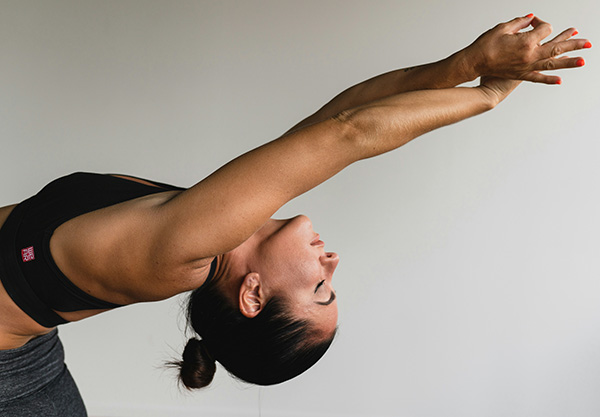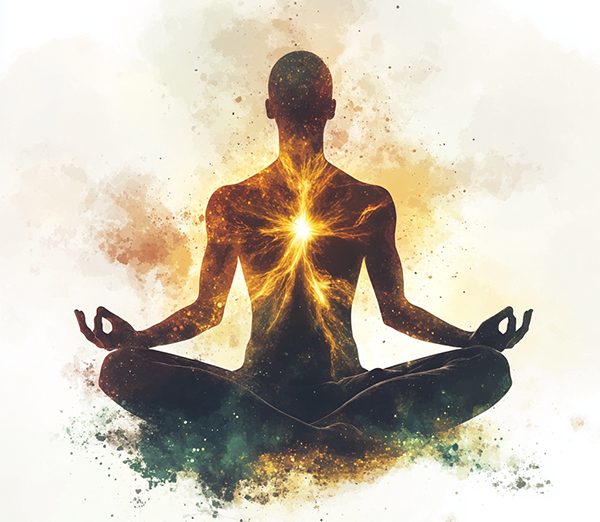
The other day I was thinking about how two people can do the same movements within a qigong practice, and for one of them – they are filled with power, grace, and energy flow, while for the other – they are just moving. (I often find myself thinking about different aspects of qigong, and different people’s experience with it 😊). This difference in quality within the movement is very evident to the skilled eye, but I think it is also often quite clear to an inexperienced eye as well. They are just often not able to put their finger on what the differences are immediately. As I pondered these starkly contrasting experiences with the same movement, it occurred to me that you could sum up the many individual factors that lead to these differences simply as ‘presence’.
Developing Presence
Presence has become a bit of a buzz word in new age spiritual groups, with great attention placed on being aware of what is going on in the immediate moment – as part of being truly aware and awake to the experience of life. There is great value in developing this type of awareness, and there are many different awareness or meditative practices that have been developed within these new age groups as ways to help people to achieve it. Each of these methods has value, but they are often primarily a mentally directed process. Where the body is used, it is often in the context of primarily as a tool to bring the mind into present focus – and many people find these primarily mentally directed processes challenging to make a lot of progress with.

Qigong takes the development of presence to a different level. By using a wide range of tools that bring our awareness to our present experience, it takes on a richer and more embodied form. Whats more, people often don’t realize they are developing this state of presence until it has been achieved. They are able to focus on each of the individual parts, developing skill with them in manageable chunks, until eventually they become a habit that can be easily maintained and combined together into an alive, aware, and empowered state of being. All of this comes from working with the three main regulations of qigong (mind, body, and breath) in simple practical ways, and I would suggest there is a fourth aspect of qigong that also plays a valuable role in developing this state of presence.
I will make brief notes about how each of these four aspects of qigong practice contribute to a state of presence, and why people sometimes miss developing this within their practice. I will then conclude with some comments about the value that comes from being truly present.
1 – Mind
Our mind of course plays a very direct role in our awareness of the present moment. Within qigong this is developed in a number of ways. A big part of this comes from simple awareness of our body as we do different movements, noticing how tensions change through the body, and how different parts are affected – like the massaging of different organs, or stretching and stimulation of the spine as we move. In addition to this there are also a variety of meditative practices that are used to develop the connection between our mind and body, facilitating greater awareness, the ability to focus, and helping us to be able to tune in to more and more subtle aspects of our experience.
There is so much going on moment to moment within our bodies and minds, that most of us are blissfully unaware of most of it. Qigong practice helps us to direct our attention to really noticing what is going on, noticing the subtle details and becoming aware of things we hadn’t before, or perhaps were even avoiding.
2 – Body
Our bodies are used extensively within qigong practice. Part of the way this develops presence is by learning to use our bodies in more harmonious ways. Doing things like aligning our posture and joints so that there isn’t excessive pressure on the body. Learning to move fluidly and efficiently so that we don’t strain or injure ourselves. Learning to release unnecessary excess tension and so on. All of these things make our body a more comfortable place to be – and more pleasant to be truly aware of.
We also learn directly about the connection between our mind and body, and so start to notice the way that different postures which we may assume unknowingly, actually give us an indication of what is going on within our minds. This is more than simply awareness, it is developing skill with how we use our body, and knowledge of how it works. Little by little we come to know ourselves better and how we are responding to the environment around us.

3- Breath
Our breath is the great bridge between mind and body, and through working with it consciously we can powerfully affect both of these. Specific breathing practices give us the ability to induce certain states within both our mind and body that open the door to a deeper awareness of what is going on within. Through the breath we are able to enter a state that starts to make what would usually be unconscious conscious to us.
Further, we learn to use the breath to harness this connection between our mind and body and actively direct the flow of our energy within us. Again, this is more than just awareness, it is a set of skills that then leads to enhanced perception and ability.
4 – Energy
This leads us the fourth aspect of qigong which I mentioned that I think also plays a particularly valuable role in the development of presence. And that is the way that qigong focuses directly on energy within all of its practices.
There is so much going on within our body, within our mind, within our environment around us, that it is simply impossible for us to attend to (focus on) all of these parts at once. Yet… if we choose to focus on one part of our experience to the exclusion of another – then are we really being present? I think not.
In many ways the living energy or ‘qi’ we speak of in qigong practice is the sum of all of the component parts of our experience. It includes all of the myriad functions of our body going on at any moment. This energy is shaped and influenced by the way our mind directs all of these functions within our body. It is even a way we can sum up what we experience in our interaction and connection with the world around us. When we focus on our energy (qi) we are in a very real way becoming more fully present – because it allows us to experience the fulness of our experience, by reducing its myriad parts down to one thing we can put our awareness on. Everything is included, and nothing is left out.
This focus on energy leads to a fuller and richer sense of awareness and presence.

Empty Practice – Why People Sometimes Fail to Develop Presence
So… if qigong has all of these valuable tools naturally embedded within it, why does the situation I mentioned at the beginning of this article occur? Where one person doing a practice is filled with power, grace, awareness, and energy flow – or presence, and another is simply moving their body?
Quite simply while all of these tools are embedded within the practices, that doesn’t mean that the practitioner is necessarily making full use of all of them. If they focus on just one part of their practice and not the others, then they will not get the full effect. It is quite common for someone to have only been taught some aspects of the practice, or even if they have been taught more, to have chosen to focus on only one part. And to be fair – even if they only focus on one part, they will still get a lot of benefit. If they focus on the movements they will get the physical stimulation which will stretch and massage and bring balance to their posture and so on. If they emphasise only on the mind and perhaps some of the more meditative practices, they will develop skill at focusing and directing their awareness, often in many useful ways. If they focus only on the breath – this will still tend to have a harmonizing effect between mind and body, and they will get many physical and psychological benefits from it.
But… to get the full effect, the full potential power and presence that can be found within the practice, all of these parts need to come together, and usually this takes time, and practice, and the correct methodology that lets you develop each of these parts to their fullest. That is the ‘gong’ part of qigong. The qi translates as energy, the gong translates as work, or skill – with and implied meaning that this comes with practice over time.
The Value of Being Truly Present
Being truly present, by definition means to have a more full and rich experience of life. When we are truly present, we are able to able to accept life as it is without distortions. That means we are able to make better choices and steer our way through the many experiences that life offers with more grace, and more skill. Being fully present means that we are also able to bring all of our resources and capabilities into harmony with one another, and thus direct them more effectively to our purposes. On a purely physical level, this means that we use all of our senses – sight, hearing, smell, taste, touch, and possibly others together in a balanced way to gain a more accurate understanding of what is going on. When we need to act it means that all of our physical capabilities are harnessed together – our muscles, connective tissue, blood flow, nerve and organ activity, for more effective action. You can see why historically qigong was so highly valued for health, high performance, and for spiritual pursuits!
And, as we develop habits of being present within our qigong practice, little by little these habits spread out into the other aspects of our lives as well. Our whole life becomes a kind of qigong practice, filled with awareness and presence.

Getting Started With Qigong
If you would like to consider using qigong as a way to more fully develop your presence, or if you would like to bring presence more fully into your qigong practice and make sure you are getting all of the potential benefit from your practice, then there are a few resources I can point you to.
The first that I would highly recommend is the free Introduction to Qigong Theory and Practice course. This gives you a great background understanding of qigong, what it is, where it came from and so on. It also lays out how the three main tools of qigong are applied within practice, and gives you practical exercises working with each of these individually, and then combined, so that you can gain your own experiential understanding of the valuable role each of these tools play, and how they can be combined together effectively.
I would also highly recommend the free The Complete Natural Breath course. Breathing is a foundational skill for qigong, and also for life! This free course contains exercises that will help you to develop your breath so that you can breathe freely and easily in your qigong practice, and also as you go about your daily activities.
If you are interested in trying more specific qigong practices, we have free videos of a variety of qigong practices that you can follow along with here. You can also try our live streaming qigong classes which you can find information about here. When you are ready to go further, we have a range courses that go into all the details and principles behind a range of different practices. You can find short courses on individual topics here, and very comprehensive courses that go deep into a whole area of practice here.
You might like to also browse around through our articles on a wide range of practical topics relating to qigong here.